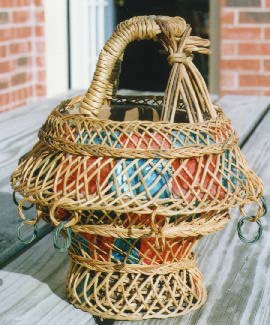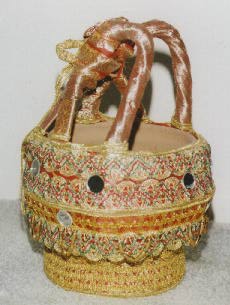Kaeshir
Ka:ngir
In a typical koshur
household, the kangir continues to be the main, inexpensive source of keeping
an individual warm during the winter months. A kangir is made up of two
parts. The outer part is an encasement of wicker. Inside, there is an earthen
bowl-shaped pot called a kondul. The kondul is filled with tsini (charcoal)
and embers. A medium sized kangir holds about a pound of tsini, and its
fire lasts for over six hours. Many Kashmiris fill a kangir with toh (chaff)
or (guh') lobar (dry cowdung). A kangir is a constant comapnion of Kashmiris
during the winter months. It is normally kept inside the Kashmiri cloak,
the ph'aran, or inside a blanket if the person does not wear a ph'aran.
If a person is wearing a jacket, it may be used as a hand-warmer.
 
Mahr'ni Kangir
The origin of the kangir is not known. Knowles
(1885) makes the following observation:
It has been suggested that the Kashmiris
learnt the use of the k'angar from the Italians in the retinue of the Mughal
Emperors who often visited the valley, but no reliable particulars have
as yet been ascertained.
In Kashmiri folklore the kangir has occupied a prominent
place. In the following poem we see the role of the kangir in a Kashmiri's
life. (see J. H. Knowles, A Dictionary of Kashmiri Proverbs and Sayings,
Bombay, 1885, p. 128)
ma:g o:y dra:g vothuy, ka:gri:,
pha:gun o:y za:gun tso:y, ka:gri:,
tsithir o:y mithir p'oy, ka:gri:.
vah'ak o:y rah'akh kati:, ka:gri:,
ze:th o:y bre:th gayakh, ka:gri:,
ha:r o:y la:r leji:, ka:gri:,
sra:vun o :y ya:vun su:ruy, ka:gri:,
ba:dirp'ath o:y vadir peyi:, ka:gri:,
a:sid o:y ka:sid su:zmay, ka:gri:,
ka:rtikh o:y na:ritikh lazmai, ka:gri:,
mojiho:r o:y koji lajay, ka:gri:,
poh o:y toh lodmay, ka:gri:.
A free translation of the above poem is given below.
The kashmiri months, like ma:g and pha:gun, roughly correspond to the Christian
calendar, January and February. However, there is no one-to-one correspondence.
ma:g came and you were hard to get, hay
ka:gri:,
pha:gun came and a plot was laid against you,
hay ka:gri :,
tsithir came and no one cared about you, hay
ka:gri:,
vah'ak came and there was no place for you, hay
ka:gr:i :,
ze:th came and you became useless, hay ka:gri:,
ha:r came and you were chased away, hay ka:gri:,
shra:vun came and your youth disappeared, hay
ka:gri:,
be:dirp'ath came and sickness came to you, hay
ka:gri:,
a:shid came and I sent you a messenger, hay ka:gri:,
ka:rtikh came and I put some embers in you, hay
ka:gri:,
mojiho:r came and we became concerned about you,
hay ka:gri:,
poh came and I filled you up with toh, hay ka:gri:,
The mahr'ni kangir is specially made for brides.
On the first he:rath (Shivratri) after getting married, a bride brings
a specially decorated kangir to her in-laws' house. These have elaborate
ornamentation and usually have a silver tsa:lan. The mahr'ni kangir are
not terribly comfortable because of their size, but they are extremely
attractive and used essentially for decoration.
The tsa:lan looks like a small 'cake server' and
is used to turn the coal inside a kangir in order to increase the heat.
It is usually tied to a round wicker hook on the back of the kangir. The
expensive kangri have silver tsa:lni with silver chains. An inexpensive
kangir has a wooden tsa:lan attached by a string.
The sur' kangir is a small kangir specially made
for small children. These vary in their size.
The kondul is a bowl-like pot which holds the tsini, charcoal, and
tyongal. The kondal (plu.) vary in size according
to the size of the kangir.
The term tsini means charcoal in general, but
for the kangri, a special type of charcoal is used. People usually prefer
charcoal of bo:ni (chinar) leaves.
<<<
Click here for Audio clips >>>
Text reproduced from:
An
Introduction to Spoken Kashmiri
by Braj B. Kachru
Department of Linguistics, University of Illinois
Urbana, Illinois 61801 U.S.A.
June, 1973
|

